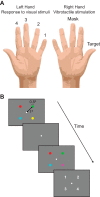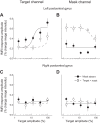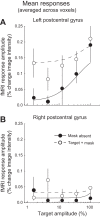Normalization in human somatosensory cortex
- PMID: 26311189
- PMCID: PMC4637367
- DOI: 10.1152/jn.00939.2014
Normalization in human somatosensory cortex
Abstract
Functional magnetic resonance imaging (fMRI) was used to measure activity in human somatosensory cortex and to test for cross-digit suppression. Subjects received stimulation (vibration of varying amplitudes) to the right thumb (target) with or without concurrent stimulation of the right middle finger (mask). Subjects were less sensitive to target stimulation (psychophysical detection thresholds were higher) when target and mask digits were stimulated concurrently compared with when the target was stimulated in isolation. fMRI voxels in a region of the left postcentral gyrus each responded when either digit was stimulated. A regression model (called a forward model) was used to separate the fMRI measurements from these voxels into two hypothetical channels, each of which responded selectively to only one of the two digits. For the channel tuned to the target digit, responses in the left postcentral gyrus increased with target stimulus amplitude but were suppressed by concurrent stimulation to the mask digit, evident as a shift in the gain of the response functions. For the channel tuned to the mask digit, a constant baseline response was evoked for all target amplitudes when the mask was absent and responses decreased with increasing target amplitude when the mask was concurrently presented. A computational model based on divisive normalization provided a good fit to the measurements for both mask-absent and target + mask stimulation. We conclude that the normalization model can explain cross-digit suppression in human somatosensory cortex, supporting the hypothesis that normalization is a canonical neural computation.
Keywords: fMRI; forward model; normalization; somatosensory cortex; suppression.
Copyright © 2015 the American Physiological Society.
Figures






References
-
- Albrecht DG, Hamilton DB. Striate cortex of monkey and cat: contrast response function. J Neurophysiol 48: 217–237, 1982. - PubMed
Publication types
MeSH terms
Grants and funding
LinkOut - more resources
Full Text Sources
Other Literature Sources

